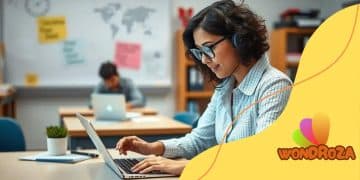The shift to remote learning and its impact on education

The shift to remote learning and its long-term impact on education includes increased technology use, hybrid models, and a focus on personalized and social-emotional learning to better prepare students for future challenges.
The shift to remote learning and its long-term impact on education has changed the educational landscape. How does this new normal affect students and teachers? Let’s dive into this topic together.
Understanding the shift to remote learning
The shift to remote learning has triggered significant changes in how education is delivered today. Understanding these shifts can help us appreciate the evolving landscape of education.
Firstly, let’s look at the key aspects of this transformation.
Key Features of Remote Learning
Remote learning isn’t just about staying at home; it includes various elements that redefine the educational experience. Here are some notable features:
- Flexibility: Students can learn from anywhere at their own pace.
- Access to Resources: Online platforms provide a wealth of materials and tools.
- Collaboration: Virtual classrooms encourage teamwork through digital platforms.
As we continue to explore remote learning, it’s essential to recognize its impact on students. Many learners find it easier to manage their time effectively since they can tailor their schedules. This is one of the greatest advantages of remote education, as it allows students to balance their studies with other commitments.
Additionally, teachers have adapted their strategies to engage students in a virtual environment. They utilize various online tools and technology to keep classes interactive. The push for training teachers in technology usage has significantly increased. It’s a positive note on how challenges can foster growth.
However, the transition to remote learning isn’t without its challenges. Students might face issues like distractions at home or the lack of motivation to participate actively. But understanding such obstacles can lead us to better solutions.
In summary, while we embrace the shift to remote learning, it’s vital to recognize both its advantages and challenges. This understanding helps us pursue improvements in the educational experience for everyone involved.
Benefits of remote education for students
The benefits of remote education for students are numerous and varied, transforming the learning experience significantly. This new approach to learning offers flexible options that can enhance engagement and accessibility.
Flexibility in Learning
One of the most notable advantages of remote education is the flexibility it provides. Students can attend classes and complete assignments from anywhere, allowing them to create a schedule that works best for them. This adaptability can lead to a better work-life balance and allows learners to manage other commitments, such as jobs or family responsibilities.
Access to a Wider Range of Resources
Remote education also opens the door to a broader range of educational resources. Here are some significant points:
- Online Libraries: Students can access a vast collection of eBooks and academic journals.
- Educational Videos: Platforms like YouTube and educational sites provide tutorials and lectures.
- Global Learning Opportunities: Students can connect with educators and peers from around the world, enriching their learning experience.
Furthermore, remote education tends to emphasize self-directed learning. As students navigate their studies independently, they frequently develop essential skills like time management, organization, and self-discipline. These skills are invaluable, not only in education but also in the workforce.
Another benefit is the personalized learning experience that remote education can offer. With technology, teachers can tailor lessons to meet individual student needs, focusing on specific areas for improvement. This customization promotes a more effective learning experience.
Overall, as students adapt to this new environment, the benefits of remote education continue to unfold, enabling them to thrive academically and personally.
Challenges faced by educators

The challenges faced by educators in the era of remote learning have significantly increased. With the sudden shift to online platforms, teachers have had to adapt quickly to new technologies and methodologies.
Tech-Savvy Demands
One major challenge is becoming proficient in various digital tools. Teachers are now required to use software for video conferencing, grading, and assignments. Adapting to these tools can be overwhelming, especially for those who are less comfortable with technology.
Student Engagement
Another challenge lies in engaging students who are learning remotely. Keeping students focused and motivated is difficult without face-to-face interaction. Many educators struggle to find ways to make their lessons interactive and enjoyable.
Here are some common ways this issue manifests:
- Distractions: Students may face distractions at home, leading to difficulties in concentrating during lessons.
- Participation: Some students may feel shy or reluctant to participate in virtual discussions.
- Feedback: Providing timely feedback can be more complicated in a remote setting.
Moreover, maintaining communication with parents has become essential yet challenging. Teachers must update parents on their children’s progress and address concerns regularly, creating a need for clear communication channels.
As educators navigate this landscape, the pressure to produce effective learning outcomes remains high. They must continuously re-evaluate their teaching strategies and be adaptable to the varying needs of their students. This endeavor requires substantial effort, commitment, and creativity in a primarily online environment.
The role of technology in remote learning
The role of technology in remote learning has become pivotal in shaping how education is delivered today. With the rise of online platforms, technology enables a flexible and interactive learning experience for students and teachers alike.
Facilitating Online Classes
One of the core functions of technology is facilitating online classes. Video conferencing tools such as Zoom and Google Meet allow educators to conduct lessons in real-time, helping students feel connected to their peers and teachers.
Access to Educational Resources
Moreover, technology provides students with access to a wide array of educational resources. This includes:
- Interactive eBooks: Students can engage with dynamic content that enhances learning.
- Online Learning Platforms: Sites like Khan Academy and Coursera offer courses on diverse subjects.
- Learning Management Systems: Tools such as Moodle and Blackboard help organize materials and communicate with students effectively.
This ease of access encourages students to explore topics further, fostering a deeper level of understanding. However, technology’s role isn’t limited to just providing resources; it also facilitates collaboration and interaction among students.
Online discussion forums and group projects enable students to connect and work together, promoting a sense of community even when physically apart. This collaborative aspect is crucial in engaging students and enhancing their learning experience.
While challenges exist, such as access disparities and technological literacy, the overall impact of technology in remote learning has been transformative. As educators continue to adapt their teaching styles, the influence of technology will likely grow, evolving the educational landscape further.
Future perspectives on education post-pandemic
The future perspectives on education post-pandemic are exciting and full of potential. As schools and educators adapt to their new realities, several trends are emerging that may shape the future of learning.
Hybrid Learning Models
One significant change is the rise of hybrid learning models. Combining in-person and online education, these models allow for flexibility while addressing the needs of various learners. Students can benefit from both classroom interaction and the convenience of remote learning. This blend also prepares them for a future where remote work might become more common.
Increased Focus on Technology
Technology will undoubtedly play a pivotal role moving forward. Areas of focus will likely include:
- Personalized Learning: Adaptive learning technologies can tailor education to meet the individual needs of each student.
- Enhanced Online Resources: Teachers will continue to use and develop diverse online materials, fostering engagement and understanding.
- Skill Development: Emphasis on digital skills and critical thinking will prepare students for a rapidly changing job market.
As we look to the future, educators are also expected to undergo continuous professional development. This commitment ensures they remain skilled in using new tools and teaching strategies effectively. Collaboration and sharing best practices will be crucial as schools adapt and learn from each other.
Moreover, there may be a growing emphasis on social-emotional learning. Recognizing the challenges faced by students during the pandemic, schools will likely prioritize mental health support and community building within the classroom.
With all these trends converging, it is clear that education will not be the same as it was before. The post-pandemic landscape offers opportunities for innovation, inclusivity, and progress.
FAQ – Questions about the Future of Education Post-Pandemic
What are hybrid learning models?
Hybrid learning models combine in-person and online education, allowing for greater flexibility and engagement in learning.
How will technology impact future education?
Technology will enhance personalized learning experiences, provide access to diverse resources, and prepare students with essential digital skills.
Why is social-emotional learning important?
Social-emotional learning helps students develop emotional intelligence, resilience, and supportive relationships, which are crucial for their overall well-being.
What skills will be emphasized in future education?
Future education will focus on critical thinking, digital literacy, and collaboration skills necessary for success in a rapidly changing job market.





